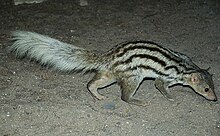Madagascar mongoose
| Madagascar mongoose | ||||||||||||
|---|---|---|---|---|---|---|---|---|---|---|---|---|

Ring- tailed Mongoose ( Galidia elegans ) |
||||||||||||
| Systematics | ||||||||||||
|
||||||||||||
| Scientific name | ||||||||||||
| Galidiinae | ||||||||||||
| Gray , 1865 |

The Madagascar mongooses (Galidiinae) are a subfamily of the Malagasy carnivores (Eupleridae) endemic to Madagascar . They include six species in four genera.
features
Madagascar mongooses reach a head body length of 26 to 48 centimeters, a tail length of 16 to 33 centimeters and a weight of 500 to 1700 grams. They are slim and elongated and their legs are short. The bushy tail covers half to two thirds of the length of the body. Their flattened skull is elongated and provided with a pointed snout. Their fur is grayish or brown, three of the six species have vertical stripes.
distribution and habitat
These animals are endemic to Madagascar . Their habitat is predominantly forests, only the ring-tailed mongoose can be found in forest edge areas. The animals are found in all forest forms on their home island, both in the rainforests of the east coast and in the deciduous forests of the west coast and the dry thorn forests in the southwest.
Way of life
Madagascar mongooses usually stay on the ground, but can climb and swim well. Three of the species are active during the day, but the broad-striped mongooses mainly forage at night. They use earthworks, rock caves, fallen tree trunks and other places to sleep. The social behavior of many species is hardly known. There have been observations of solitary animals or animals living in family groups.
These animals are carnivores that feed on both small vertebrates and invertebrates.
Madagascar mongooses and people
In some regions, Madagascar mongooses have a bad reputation, as they are said to tear poultry. The main threat, in addition to hunting, is the ongoing destruction of their habitat. With the exception of the ring-tailed mongoose, all species are endangered.
Systematics
Traditionally, the Madagascar mongooses were led as a subfamily of the mongooses (Herpestidae), to which they are similar in physique. According to recent genetic studies, however, they do not belong to this family, but are part of the newly established Malagasy carnivores (Eupleridae), which includes all carnivores in Madagascar - in addition to the Madagascar mongooses, these are also the Euplerinae ( Fossa , Falanuk and Fanaloka ).
The group includes six species in four genera:
- Ring- tailed Mongoose ( Galidia elegans )
-
Broad-striped mongoose ( Galidictis )
- Broad-striped mongoose ( Galidictis fasciatus )
- Greater broad-striped mongoose ( Galidictis grandidieri )
- Narrow-striped mongoose ( Mungotictis decemlineata )
-
Salanoia
- Plain mongoose ( Salanoia concolor )
- Salanoia durrelli
Whether the Madagascar mongooses are actually monophyletic , that is, form a natural family group, has not been fully clarified. The molecular finding suggests that at least ring-tailed mongoose, broad-striped mongoose and narrow-striped mongoose form a group of closely related animals; the position of the common mongoose is unclear.
supporting documents
- ↑ J. Durbin, SM Funk, F. Hawkins, DM Hills: Investigations into the status of a new taxon of Salanoia (Mammalia: Carnivora: Eupleridae) from the marshes of Lac Alaotra, Madagascar. Systematics and Biodiversity 8 (3), September 2010, 341–355 doi : 10.1080 / 14772001003756751
literature
- Don E. Wilson, Russell A. Mittermeier (Eds.): Handbook of the Mammals of the World. Volume 1: Carnivores. Lynx Edicions, 2009, ISBN 978-84-96553-49-1 .
- Ronald M. Nowak: Walker's Mammals of the World . Johns Hopkins University Press, 1999 ISBN 0-8018-5789-9